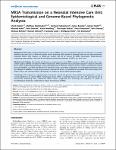MRSA Transmission on a Neonatal Intensive Care Unit: Epidemiological and Genome-Based Phylogenetic Analyses
Nübel, Ulrich
Nachtnebel, Matthias
Falkenhorst, Gerhard
Benzler, Justus
Hecht, Jochen
Kube, Michael
Bröcker, Felix
Moelling, Karin
Bührer, Christoph
Gastmeier, Petra
Piening, Brar
Behnke, Michael
Dehnert, Manuel
Layer, Franziska
Witte, Wolfgang
Eckmanns, Tim
Background: Methicillin-resistant Staphylococcus aureus (MRSA) may cause prolonged outbreaks of infections in neonatal intensive care units (NICUs). While the specific factors favouring MRSA spread on neonatal wards are not well understood, colonized infants, their relatives, or health-care workers may all be sources for MRSA transmission. Whole-genome sequencing may provide a new tool for elucidating transmission pathways of MRSA at a local scale. Methods and Findings: We applied whole-genome sequencing to trace MRSA spread in a NICU and performed a case-control study to identify risk factors for MRSA transmission. MRSA genomes had accumulated sequence variation sufficiently fast to reflect epidemiological linkage among individual patients, between infants and their mothers, and between infants and staff members, such that the relevance of individual nurses’ nasal MRSA colonization for prolonged transmission could be evaluated. In addition to confirming previously reported risk factors, we identified an increased risk of transmission from infants with as yet unknown MRSA colonisation, in contrast to known MRSA-positive infants. Conclusions: The integration of epidemiological (temporal, spatial) and genomic data enabled the phylogenetic testing of several hypotheses on specific MRSA transmission routes within a neonatal intensive-care unit. The pronounced risk of transmission emanating from undetected MRSA carriers suggested that increasing the frequency or speed of microbiological diagnostics could help to reduce transmission of MRSA.
Dateien zu dieser Publikation
Keine Lizenzangabe

